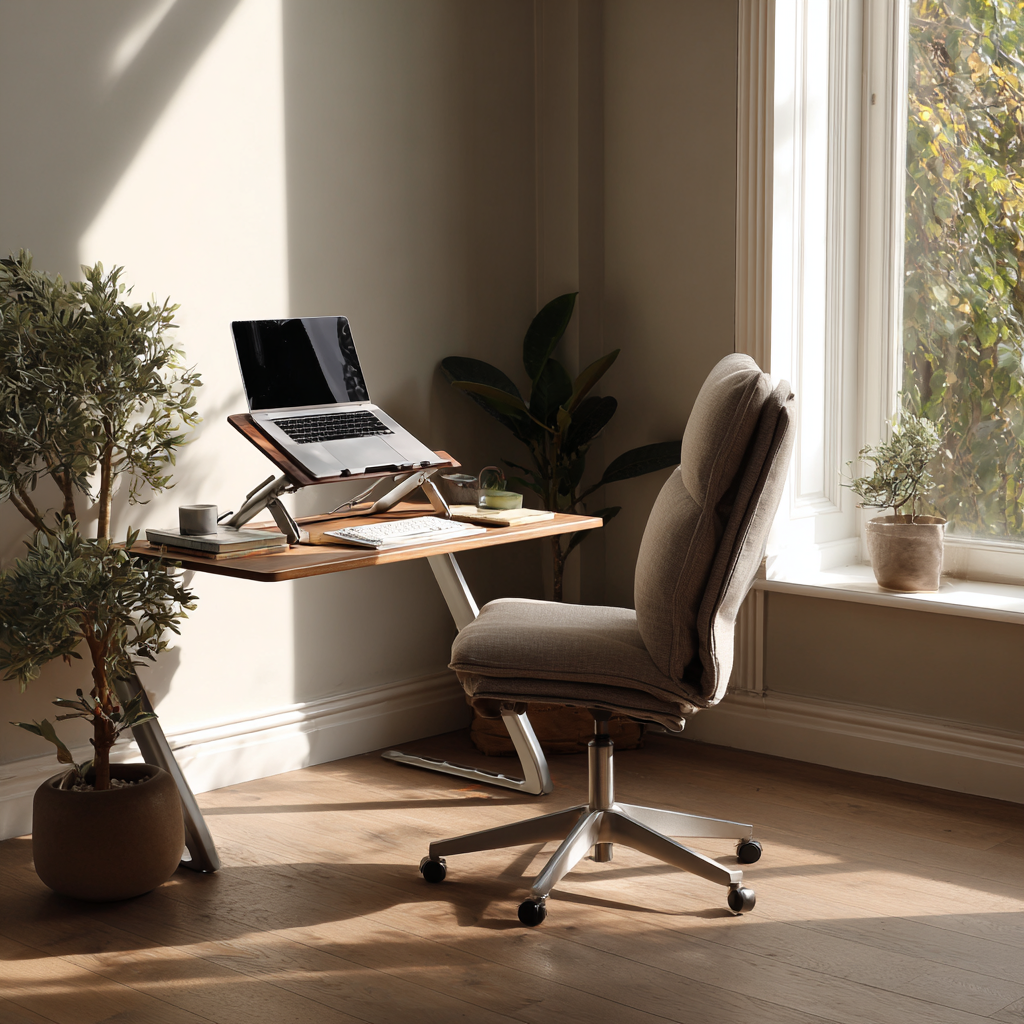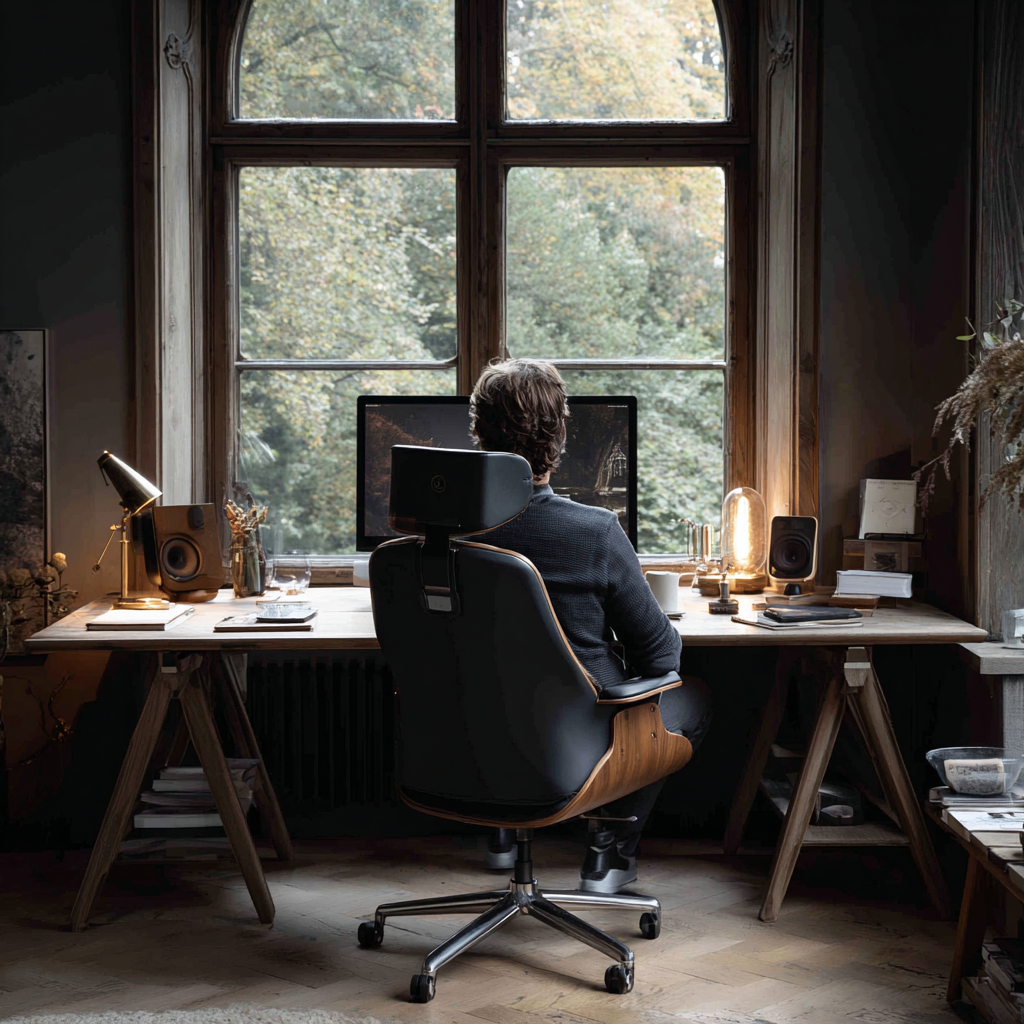
How to Get More Done Without Fatigue
Many professionals begin the day with focus and momentum, only to experience a noticeable decline by mid-afternoon. Tasks that felt manageable in the morning begin to require more effort, and productivity slows. This is not simply a matter of willpower or motivation. More often, it reflects the combined impact of physical fatigue, prolonged sitting, and a work environment that places strain on the body.
Research shows that fatigue and discomfort are among the most significant barriers to sustained performance in knowledge-based work. When the body is misaligned or under strain, energy is depleted more rapidly, concentration diminishes, and even routine responsibilities can feel burdensome.
The encouraging reality is that fatigue can be managed — and in many cases prevented — with intentional strategies. By incorporating ergonomic support, adopting wellness-oriented work habits, and using tools designed to align the body with the demands of the task, professionals can maintain consistent energy levels and work at a higher capacity throughout the day.
In this article, we will examine the most effective approaches to reducing physical strain, promoting focus, and ensuring that productivity does not decline as the afternoon progresses.

Quick Wins for Lasting Productivity
Improving energy and focus during the workday does not require a complete office redesign. In many cases, small, intentional adjustments can deliver significant benefits, particularly in combating the well-documented afternoon slump.
Why Fatigue Peaks Mid-Afternoon
Several factors converge to make the hours between 1–3 PM especially challenging for concentration and performance:
-
Circadian rhythm dip: Human energy levels naturally decline during early afternoon hours, a biological rhythm that makes sustained focus more difficult.
-
Static posture: Remaining seated for long periods reduces circulation, which contributes to muscle stiffness and a sense of sluggishness.
- Visual strain: Poor screen positioning, inadequate lighting, or glare accelerate eye fatigue and intensify feelings of tiredness.
Practical Adjustments You Can Implement Immediately
Even small changes in daily routines can reduce strain and preserve focus:
- Take micro-breaks: Set reminders to stand, stretch, or walk briefly every 45–60 minutes. These pauses reduce spinal compression and restore circulation.
- Rest the eyes: Follow the 20-20-20 rule — every 20 minutes, shift your gaze to an object at least 20 feet away for 20 seconds. This relieves visual strain and helps prevent headaches.
- Optimize lighting: Exposure to natural light has been shown to reduce fatigue by over 50% compared to artificial lighting. Whenever possible, position your workspace near a window or use full-spectrum lighting to simulate daylight.
These strategies require minimal effort yet can deliver measurable improvements in both comfort and performance. By integrating them into the workday, professionals can counteract natural dips in energy and maintain steady productivity well beyond mid-afternoon.

The Ergonomic Advantage
The way your workspace is arranged has a direct impact on how much energy you can sustain throughout the day. Ergonomics is not limited to comfort — it is fundamentally about efficiency. When the body is properly supported, it expends less energy on maintaining posture and resists the fatigue that often sets in by mid-afternoon. A well-designed ergonomic setup ensures that your muscles, joints, and circulation all work in balance, allowing you to stay productive for longer periods without strain.
| Element | Ideal Setup | Why It Matters |
|---|---|---|
| Chair | Hips slightly above knees, with lumbar and back support | Maintains spinal alignment and reduces lower back strain |
| Monitor | Top of the screen at eye level, placed about arm’s length away | Prevents forward head posture and reduces both neck and eye strain |
| Keyboard/ Mouse | Elbows bent at 90°, wrists kept straight | Minimizes shoulder tension and reduces risk of repetitive strain in wrists and arms |
| Foot Position | Feet flat on the floor or supported by a footrest | Improves circulation, prevents leg fatigue, and reduces pressure on the lower back |
Practical Solution
Even a single adjustment can make a measurable difference. For example, the Serenform Axis Footrest elevates the feet to create proper alignment between the hips, knees, and spine. By promoting balanced posture and reducing pressure on the lower back, it helps conserve energy and minimize fatigue across long work sessions.

Work Smarter With Wellness Habits
Even with the best ergonomic setup, the body still requires proper care to perform at its highest level. Ergonomics reduces strain, but energy is also influenced by how well you hydrate, nourish, and move throughout the day. Integrating simple wellness practices into your workflow ensures that you are not only working longer, but also working more effectively.
Wellness Habits That Sustain Energy
- Stay Hydrated: Even mild dehydration can reduce concentration and increase fatigue by up to 25%. Keeping a water bottle within reach and sipping regularly throughout the day helps maintain cognitive performance.
- Choose Smarter Snacks: Reaching for chips or sweets may provide a quick boost, but it often leads to an energy crash. Alternatives such as almonds, fruit, or yogurt stabilize blood sugar and provide lasting fuel for the brain.
- Practice Intentional Breathing: Short mindfulness breaks or deep breathing exercises increase oxygen flow to the brain and counteract the effects of stress. Just a few minutes can reset focus and improve clarity.
- Incorporate Movement: A five-minute walk, stretch, or even standing during phone calls every couple of hours stimulates circulation, reduces stiffness, and refreshes mental focus.
These practices do not require a major lifestyle overhaul. Instead, they function as micro-habits — small, repeatable actions that accumulate over time to protect productivity and prevent burnout. When paired with strong ergonomic foundations, they create a sustainable approach to high performance.

Tools That Make the Difference
Even the best habits cannot fully compensate for a workspace that lacks proper support. No matter how mindful you are about posture, movement, or wellness, your body still requires the right tools to prevent strain and sustain energy. Investing in ergonomic essentials is not about luxury — it is about creating a foundation for long-term health, comfort, and productivity.
Must-Have Ergonomic Tools
- Ergonomic Chair: A high-quality chair supports the natural curvature of the spine, encourages proper alignment, and reduces pressure on the lower back during extended periods of sitting.
- Seat Cushion: A well-designed cushion distributes weight evenly, reduces hip and tailbone fatigue, and improves circulation. The Serenform Summit Seat Cushion is engineered to relieve pressure points and maintain comfort for hours of seated work, making healthy posture effortless.
- Standing Desk: Alternating between sitting and standing reduces static strain, prevents stiffness, and keeps energy levels more consistent throughout the day.
- Monitor Arm or Laptop Stand: Keeping screens at eye level prevents forward head posture and significantly reduces the risk of neck pain at work. The Serenform Elevate Laptop Stand raises your laptop to the ideal height, promoting healthy alignment and flexibility as your tasks change.
- Footrest: Proper foot positioning enhances circulation and relieves pressure on the lower back. The Serenform Axis Footrest promotes balanced posture by keeping the hips, knees, and spine aligned.
These tools should be viewed as long-term investments. Beyond providing comfort, they enable consistent performance by minimizing unnecessary energy drains. An ergonomically optimized workspace ensures that your body supports your work — rather than standing in the way of it.

Study Without the Slump
Avoiding mid-session fatigue is not just a challenge for professionals. Students preparing for exams, writing papers, or tackling long reading assignments often experience the same afternoon slump that disrupts productivity in the workplace. Extended sitting, poor posture, and inadequate workspace setups can drain focus and make it harder to retain information.
The encouraging news is that the same ergonomic and productivity strategies that benefit professionals are equally effective for students. With thoughtful adjustments — many of which can be implemented on a limited budget — students can maintain energy, reduce strain, and study more effectively.
Budget-Friendly Hacks for Students
- Support the Lower Back: If an ergonomic chair is not available, use a cushion, folded blanket, or even a rolled-up towel for lumbar support. This simple adjustment helps maintain the spine’s natural curve and reduces lower back fatigue.
- Elevate the Screen: Placing a laptop on stacked textbooks or binders raises the screen to eye level, preventing the neck strain that develops from looking downward for hours.
- Structure Study Time: Apply the Pomodoro Technique - work in focused blocks of 25 - 50 minutes, followed by a 5-minute break. This method improves concentration and prevents the mental fatigue associated with long, uninterrupted sessions.
- Use a Footrest Alternative: If a dedicated footrest is not feasible, a sturdy box or stack of books can serve as a substitute. Keeping feet supported improves circulation and reinforces posture.
Ergonomic principles do not need to be costly or complicated. Even small, budget-friendly changes help prevent discomfort, conserve energy, and extend focus. For students balancing heavy academic workloads, these adjustments can make the difference between simply getting through a study session and truly excelling.

Conclusion: Smarter Work, Less Fatigue
Fatigue does not have to be a built-in part of your day. Whether you are working through a demanding schedule or studying for long hours, the combination of ergonomic support, wellness habits, and simple productivity techniques can make a significant difference. By reducing physical strain and conserving energy, you create the conditions for sharper focus, steadier output, and greater comfort throughout the day.
The key is balance: small adjustments to posture, breaks for movement, healthy fueling habits, and the right supportive tools all work together to prevent the afternoon slump. With a thoughtful approach to how you work and study, you can achieve more in less time — without the exhaustion that often comes with pushing through discomfort.
Smarter work begins with a smarter setup. By investing in these strategies, you protect both your energy and your long-term well-being, ensuring that your productivity is sustainable well into the future.


